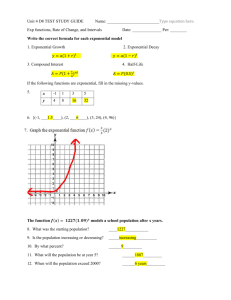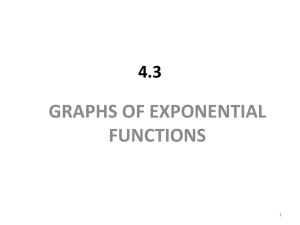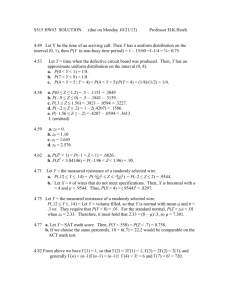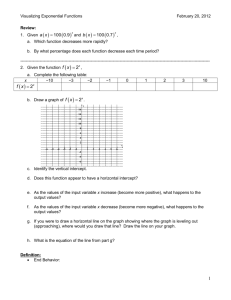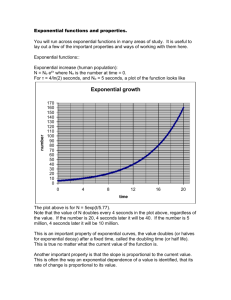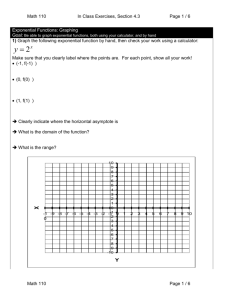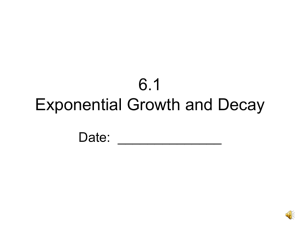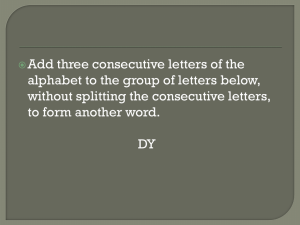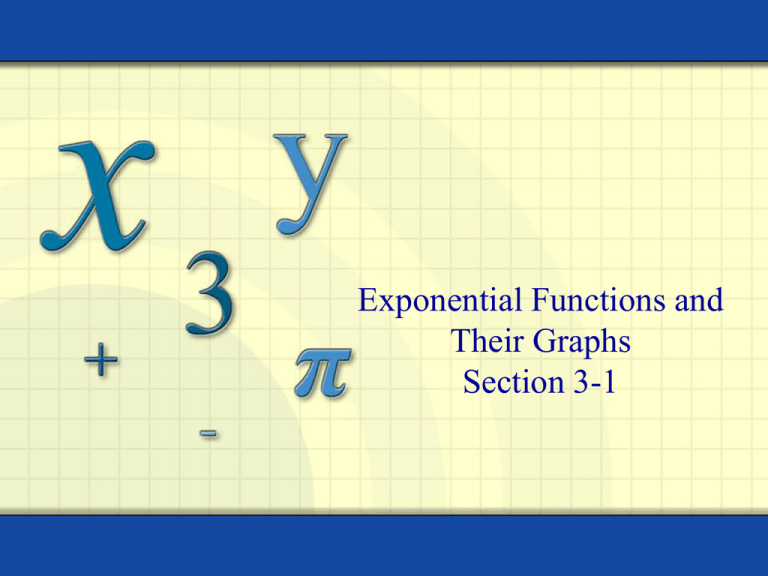
Exponential Functions and
Their Graphs
Section 3-1
The exponential function f with base a is
defined by
f(x) = ax
where a > 0, a 1, and x is any real number.
For instance,
f(x) = 3x and g(x) = 0.5x
are exponential functions.
2
The value of f(x) = 3x when x = 2 is
f(2) = 32 = 9
The value of f(x) = 3x when x = –2 is
f(–2) =
3–2
1
=
9
The value of g(x) = 0.5x when x = 4 is
g(4) = 0.54 = 0.0625
3
The graph of f(x) = ax, a > 1
Exponential
Growth
Function
y
4
Range: (0, )
(0, 1)
x
4
Domain: (–, )
Horizontal Asymptote
y=0
4
The graph of f(x) = ax, 0 < a < 1
y
Exponential
Decay
Function
4
Range: (0, )
(0, 1)
x
4
Domain: (–, )
Horizontal Asymptote
y=0
5
Exponential Function
•
•
•
•
3 Key Parts
1. Pivot Point (Common Point)
2. Horizontal Asymptote
3. Growth or Decay
6
Manual Graphing
• Lets graph the following together:
• f(x) = 2x
Copyright © by Houghton Mifflin Company, Inc. All rights reserved.
7
Example: Sketch the graph of f(x) = 2x.
x
y
f(x) (x, f(x))
-2
¼
(-2, ¼)
-1
0
1
2
½
1
2
4
(-1, ½)
(0, 1)
(1, 2)
(2, 4)
4
2
x
–2
Copyright © by Houghton Mifflin Company, Inc. All rights reserved.
2
8
Definition of the Exponential Function
The exponential function f with base b is defined by
f (x) = bx or y = bx
Where b is a positive constant other than and x is any real number.
Here are some examples of exponential functions.
f (x) = 2x
g(x) = 10x
Base is 2.
Base is 10.
Copyright © by Houghton Mifflin Company, Inc. All rights reserved.
h(x) = 3x
Base is 3.
9
Calculator Comparison
• Graph the following on your calculator at
the same time and note the trend
• y1 = 2 x
• y 2= 5 x
• y3 = 10x
10
When base is a fraction
• Graph the following on your calculator at
the same time and note the trend
• y1 = (1/2)x
• y2= (3/4)x
• y3 = (7/8)x
11
Transformations Involving Exponential Functions
Transformation
Equation
Description
Horizontal
translation
g(x) = bx+c
• Shifts
Vertical stretching or
shrinking
g(x) = cbx
Multiplying y-coordintates of f (x) = bx by c,
• Stretches the graph of f (x) = bx if c > 1.
• Shrinks the graph of f (x) = bx if 0 < c < 1.
Reflecting
g(x) = -bx
g(x) = b-x
• Reflects
Vertical translation
g(x) = bx+ c
• Shifts
the graph of f (x) = bx to the left c units if c > 0.
• Shifts the graph of f (x) = bx to the right c units if c < 0.
the graph of f (x) = bx about the x-axis.
• Reflects the graph of f (x) = bx about the y-axis.
the graph of f (x) = bx upward c units if c > 0.
• Shifts the graph of f (x) = bx downward c units if c < 0.
12
Example: Sketch the graph of g(x) = 2x – 1. State the
domain and range.
The graph of this
function is a vertical
translation of the
graph of f(x) = 2x
down one unit .
y
f(x) = 2x
4
2
Domain: (–, )
x
Range: (–1, )
y = –1
13
Example: Sketch the graph of g(x) = 2-x. State the
domain and range.
y
The graph of this
function is a
reflection the graph
of f(x) = 2x in the yaxis.
f(x) = 2x
4
Domain: (–, )
Range: (0, )
x
–2
2
14
Discuss these transformations
•
•
•
•
•
•
y = 2(x+1)
Left 1 unit
y = 2x + 2
Up 2 units
y = 2-x – 2
Ry, then down 2 units
15
Special Symbols
• Math uses special symbols at times to
represent special numbers used in
calculations.
• The symbol (pi) represents 3.14…..
• The symbol “i” represents
1
16
(The Euler #) e is an irrational #,
where
e 2.718281828…
is used in applications involving growth
and decay.
17
The graph of f(x) = ex
y
Natural
Exponential
Function
x
-2
-1
0
1
2
6
4
2
f(x)
0.14
0.38
1
2.72
7.39
x
–2
2
18
Homework
• WS 6-1
19



